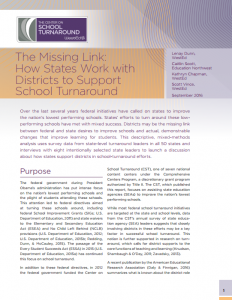The Missing Link: How States Work with Districts to Support School Turnaround
Lenay Dunn, WestEd; Caitlin Scott, Education Northwest; Kathryn Chapman,WestEd; and Scott Vince, WestEd
Over the last several years federal initiatives have called on states to improve the nation’s lowest performing schools. States’ efforts to turn around these low-performing schools have met with mixed success. Districts may be the missing link between federal and state desires to improve schools and actual, demonstrable changes that improve learning for students. This descriptive, mixed-methods analysis uses survey data from state-level turnaround leaders in all 50 states and interviews with eight intentionally selected state leaders to launch a discussion about how states support districts in school-turnaround efforts.
The CST leadership and evaluators wanted to know more about how SEAs were currently supporting districts in improving their capacity to assist with school turnaround efforts and how that support could be improved. We suspected that systematic district support might be the missing link between federal and state desires to improve schools and actual, demonstrable changes that improve learning outcomes for students. Therefore, this analysis posed the following questions:
- How do states support districts in turning around low-performing schools?
- How, if at all, do states work differently with rural versus urban districts on school turnaround, and is this differentiation important?
- How have federal policies influenced the schools and districts with which states work on school turnaround?
While some of the logistics for school turnaround efforts will be changing in various ways under ESSA, many of the details, insights, and strategies provided by SEAs through these surveys and interviews are still relevant to helping SEAs think about how to provide high-quality support to districts on school turnaround.

